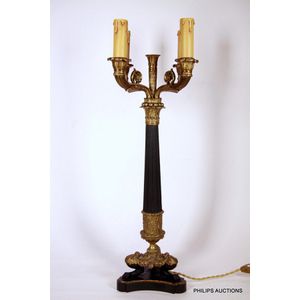19th Century Duplex Kerosene Banquet Lamp with Crystal Globe
You must be a subscriber, and be logged in to view price and dealer details.
Subscribe Now to view actual auction price for this item
When you subscribe, you have the option of setting the currency in which to display prices to $Au, $US, $NZ or Stg.
- Foliate - Decorated with leaves or leaf-like forms.
- Alabaster - Alabaster is soft natural stone used for statuary, with a similar appearance to marble, but easier to work with. As it is softer than marble, an item made from alabaster can be scratched with a metal object, and an alabaster item does not polish to a high surface gloss like marble.
Alabaster objects can be semi-translucent. Alabaster occurs in a pure white form and also with veining from dirt. Colours vary from white through yellow and pink to brown. The veining is usually green or black but can be multicoloured.
Being semi-translucent, alabaster is often used for the bowls of figural lamps, with the figure itself being either alabaster or marble. - Frieze - An architectural term denoting the flat, shaped or convex horizontal surface of furniture, between the architrave and the cornice, usually found on a cabinet or bookcase, or on desks and tables where it may include drawers, the area between the top and the legs. In ceramics, the term refers to the banding, of usually a repeating pattern, on the rims of plates and vases.
- Cranberry Glass - Cranberry glass is a type of glass that is characterized by its deep red color. It was first made in the 19th century and was particularly popular during the Victorian era. It was typically used to make decorative items such as vases and figurines. The red color was achieved by adding gold chloride or selenium to the glass mixture during the manufacturing process.
This item has been included into following indexes:
Visually similar items

An Empire style four branch candelabrum, later 19th century, with European electrical fittings, in gilded and blackened brass, the four-branch candelabrum with scrolling arms and fittings for electric candles, a fluted tapering stem with a decorative capit

An antique banquet lamp. Late 19th to early 20th century, maker's mark of John Scott, England, with a shaped chimney, kerosene font in pressed peach coloured glass and operational burner assemblies above a brass Corinthian column to a squared spreading bas

Victorian Corinthian column oil lamp (no shade or chimney)

A Webb crystal and ormolu centre piece, the central crystal bowl raised upon a stem and surrounded by six crystal vessels all supported by dragon ormolu, 70 cm high
